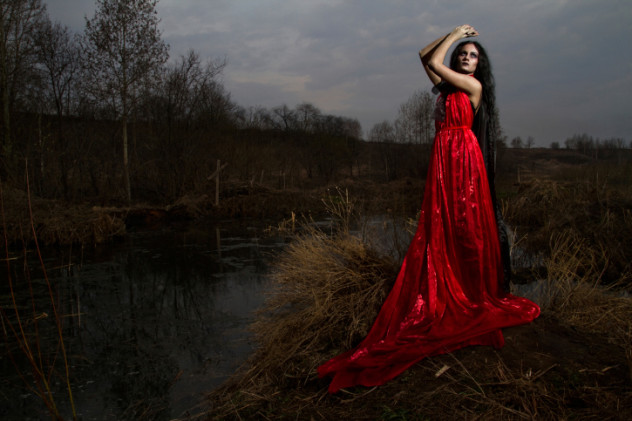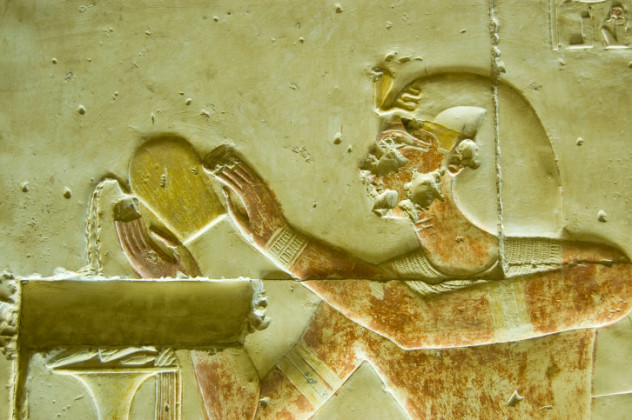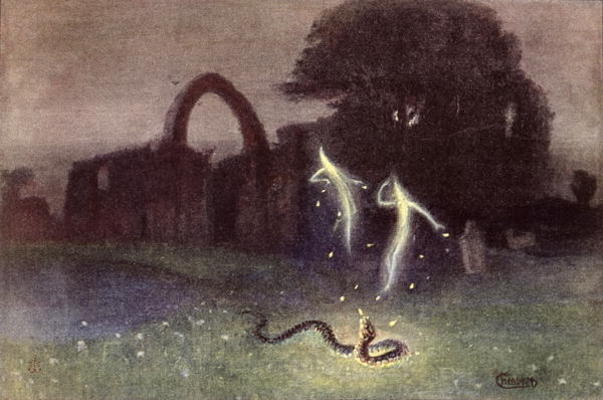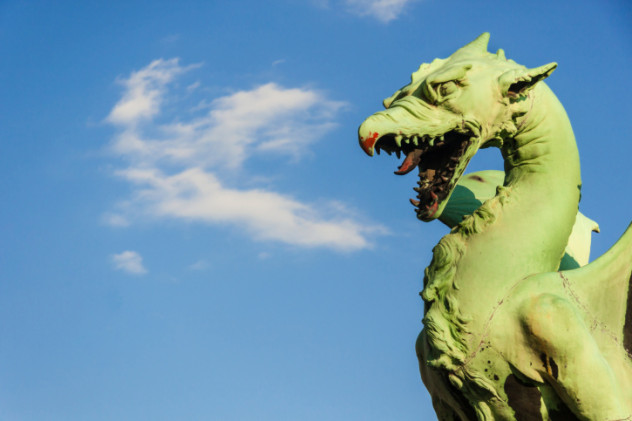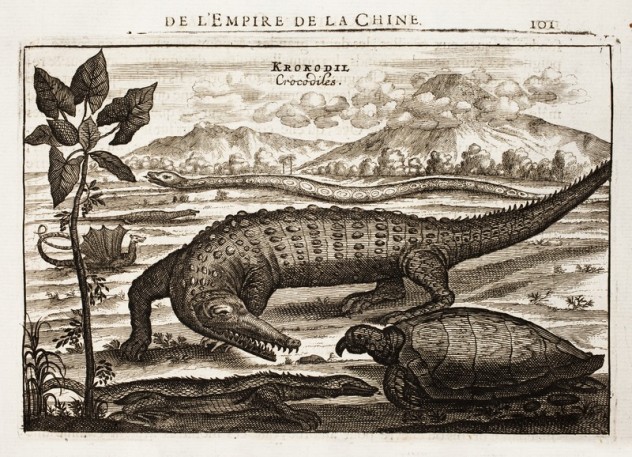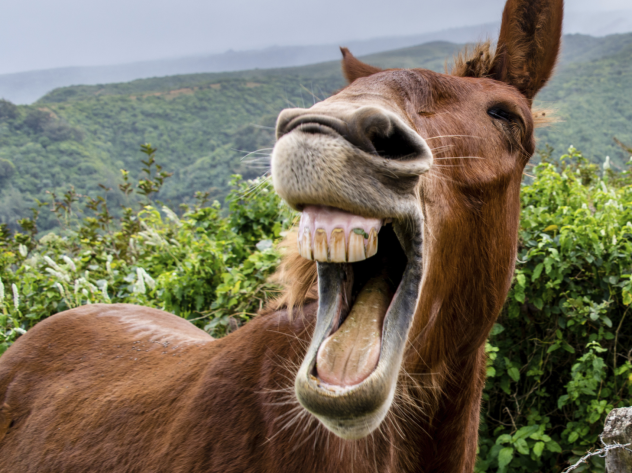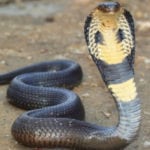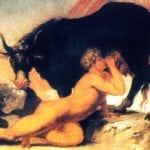10BadbIreland
The Badb is a Celtic phantom. A pale woman with a blood-stained mouth, she is often associated with two other phantom queens, the Morrigan and Macha. The Badb is a forerunner to the banshee. Legend says she hovers over the battlefield, shrieking encouragement to her allies and curses at her foes. She has the ability to speak from the mouths of corpses on the battlefield and inhabit the bodies of cows, eels, wolves, and crows. Rarely is she depicted taking part in the battle itself, but instead provokes men to fight from the sidelines, a harbinger of doom. Seeing her is seldom a good omen. Outside of battle, the Badb has a more subtle way of striking fear. She is rumored to stand over a nearby stream and wash the bloodied rags of those who will soon die in battle.
9Yacu MamaSouth America
In some versions of the legend, this giant anaconda is also considered a water spirit or perhaps a demon. The Jibaro tribe, who lives near the territory of these monsters, believe that if a snake bites a man and poisons him, it is the work of black magic. As far as the Jibaros are concerned, a dry bite from a venomous snake is the natural order of things; people only are poisoned when something evil is afoot.
8ShesmuEgypt
Shesmu, the Egyptian god of the winepress, is often depicted as a reverse sphinx—the body of a human with the head of a lion. Although he is primarily associated with wine, Shesmu is also the god of other pressed substances, like oils and perfumes. In some legends, he makes generous offerings of wine to people who are traveling through the underworld. However, that is where the kindness of Shesmu ends. Things quickly take a turn for the macabre because this dark god is also the “Lord of the Blood” and works closely with Apep, an evil god of darkness and chaos. Shesmu often takes the heads of his enemies and uses them to make wine. In other stories, Osiris himself gives Shesmu the heads of their enemies and charges him with squeezing them in his winepress to make a drink from their defeated remains. In Egyptian mythology, there is a strong symbolic link between wine and blood, with the ritualistic drinking of an opponent’s blood considered a method of gaining their power.
7Nalusa FalayaNorth America
The Nalusa Falaya is a character in the folklore of the Choctaw tribe of North America. This fearsome being is said to have the appearance of a shriveled human being with an uncharacteristically long nose and pointed ears. Native hunters believed the Nalusa Falaya to attack at twilight and bewitch them with its evil magic. It would first attract a hunter’s attention by calling out to him. Then, when the hunter turned, he was so affected by its power that he fell helpless to the ground. While its victim was unable to fight back, the Nalusa Falaya would insert a thorn in him. The Choctaw believed this led the person to unwittingly perform evil acts against others. According to the legends, people wouldn’t remember being pricked by the thorn; they would only realize it after they started performing evil. The legends also say that this demon could breed, and its children would remove their entrails at night and walk around the woods where they lived, carrying them in their hands. The stories also claim that the Nalusa Falaya’s children had a luminous appearance and showed up near swamps, a possible mythological explanation for the will-o’-wisp phenomenon.
6PeludaFrance
The Peluda appeared in the Middle Ages in the river Huisne in France and was so large and powerful that it caused flooding and destroyed farms just by entering a nearby river. This beast was a gigantic dragon-like creature, but instead of being covered entirely in scales, it had green fur on its torso and a tuft of sharp quills on its back. Like most dragons, the Peluda was capable of breathing fire, had large claws, and was notorious for causing trouble. The tales claim that this horrible abomination declined to enter Noah’s Ark, but somehow ended up in France in the Middle Ages, still alive and killing. The dragon terrorized the countryside and (as dragons tend to do) ate a lot of people. One particular local took exception to the dragon’s eating habits, especially when its latest snack had been a woman he was engaged to. When he learned that its weakest point was its tail, he decided that he had to fight the beast. Armed with this knowledge, he defeated the dragon once and for all.
5Ninki NankaWest Africa
The ninki nanka is a West African monster that usually appears in the form of a giant snake. It has some similarities to the folkloric legends of basilisks and Chinese dragons, as it is claimed that just looking at this creature can lead to your untimely death. This scaled beast is 10 meters (32 ft) long, has powerful horns on his head, and prefers to remain hidden in the mud or underwater, only coming out at night to feed. Descriptions of this monster vary, but in one incident back in the 1930s, a visiting explorer overheard villagers making allegations of a ninki nanka sighting the night before. When he questioned them about it, they told him that the monster resembled something they’d seen in a photograph—a model of a dinosaur from New York. It’s hard to say whether it is a giant snake, a dragon, or some strange combination, but it is certainly a formidable creature. Most people who see a ninki nanka die soon afterward, but one man who survived—allegedly due to an herbal remedy he got from a healer—claimed that the creature was about 50 meters (165 ft) long and that he watched the dragon-like beast for nearly an hour.
4Mula-Sem-CabecaBrazil
In Brazilian folklore, there is a very serious penalty for any woman who chooses to engage with a priest. While the priest himself faces few ramifications, the woman may end up turning into a hideous monster. In the folklore, the offense is so grave that upon every full moon, the woman will transform into a grotesque mula-sem-cabeca, or headless mule. While headless, the creature belches flames and shoots sparks from its horrible metallic hooves. It loudly brays and spreads terror wherever it goes, and only at dawn will it transform back again. The curse can be broken by beating the monstrous mule bloody. Alternately, the priest can repeatedly counter-curse the woman before a congregation. When the curse is broken, the mula-sem-cabeca immediately takes the form of the woman again.
3TokolosheSouth Africa
South Africa is home to the legend of the tokoloshe, a nasty golem capable of all sorts of vicious behavior. A tokoloshe is created through some form of necromancy or dark arts by the design of an evil sorcerer. The sorcerer can use the new servant for whatever purposes he desires. The tokoloshe is popularly depicted as a short, zombie-like creature with a hole in its head, often with a penis of enormous size. All kinds of malign powers are attributed to the tokoloshe. It can make itself invisible either by swallowing a pebble or drinking water, and it is said to be incredibly strong and poisonous. The strangest part about the tokoloshe legend is that while just seeing one is bad luck, telling anyone else about the sighting invites certain doom. By this logic, it seems like we shouldn’t know about the tokoloshe at all if it kills everyone who speaks about it—but perhaps it’s biding its time, lulling us into a false sense of security.
2ImpunduluSouth Africa
This being is often known as the lightning bird, but a better term for it might be “lightning vampire.” No, the creature doesn’t feed off lightning, but it is vampiric in nature. Rather, the Impundulu usually takes on the shape of an enormous bird that can create lightning with its powerfully magical wings. However, while a gigantic bird that can create lightning sounds more awe-inspiring than terrifying, there is a darker side to this creature. The Impundulu is nearly always bound by the power of a witch doctor, sent out to cause harm to others. According to the legends, this monster—just like vampires—really enjoys feasting on human blood. To make matters worse, he sometimes transforms himself into an attractive young man. He uses this ability to draw in women, then executes whatever task the witch doctor gave him or simply drinks her blood.
1Orang MinyakMalaysia
One of the most disturbing beings of all hails from Malaysia and is a relatively young legend. In Malaysian lore, a hantu is demonic spirit. According to one particular legend, a hantu was born from black magic back in the 1960s and quickly spread a panic. This murderous ghost was born of a horrible demonic ritual. A man wanted to have all of his worldly desires met, but he didn’t want to put forth much effort, so he made a deal with Satan. He would be given everything he wanted, but in order to fulfill his part of the bargain, he had to rape 21 virgins in seven days. According to the stories, he succeeded in his horrible crime, as the Orang Minyak was soon birthed. The modus operandi of the Orang Minyak—which means “oily man,” and reflects his appearance—was to rape women. Rumors spread quickly; it was alleged that if a woman wasn’t a virgin, the Orang Minyak was invisible to her. He could also keep his victims from speaking and moving with his demonic powers. During the hysteria, women would try to camouflage themselves as men while asleep to avoid his gaze, and it was believed that biting their own left thumbs would ward him away if he attacked.
